Email Lead Generation: What it Is and How to Do it Right

I hope you enjoy this blog post. If you want Hello Bar to grow your leads, click here.
Author:
Ryan Bettencourt
Published
June 27, 2024

Email marketing, when done right, can be one of the most cost-effective marketing tactics that help marketers achieve numerous goals. Whether you want to boost customer engagement, build relationships, or boost sales, emails can help.
In fact, email marketing can help you get as much as 36x return on your investment.
However, you need great email leads to get the best results, and that’s where email lead generation can help.
This detailed guide covers everything you need to know about email lead generation. So, let’s get started.
What is Email Lead Generation?
Email lead generation is the process through which businesses acquire email addresses of potential customers. They then nurture these leads and try to turn them into customers via email marketing.
A business can have different types of leads, both online and offline. Email leads are people who have shown an interest in your business and willingly provided you with their email contact details.
Email lead generation typically involves using opt-in forms through which prospects submit their personal information, often in exchange for an incentive. According to a survey, 84% of marketers use forms for lead generation, while some use live chats and calls.
These forms could be for newsletter signups, webinar enrollment, or anything else.
Why is Email Lead Generation Important?
As explained, email lead generation involves collecting prospective customers’ email addresses via opt-in forms.
But why do you need it in the first place? Why is email lead generation important for businesses?
Well, when you get someone’s email address, you can reach out to them via email and encourage them to engage with your business further. Collecting email leads helps you build your email lists for email marketing, which is an effective marketing strategy that can help you achieve numerous goals.
You can use email marketing to:
- Re-engage interested consumers and nudge them to buy your products or services.
- Nurture leads by sharing engaging and useful content, encouraging them to visit your website again.
- Send offers and discounts to prospects to boost sales.
- Build trust and credibility in your business by sharing the success stories of past clients.
- Connect with potential customers and build emotional connections by telling your brand story or sharing your brand values.
The possibilities are endless with email marketing and email lead generation is the first step in running a successful email campaign as it helps you build email lists.
6 Email Lead Generation Best Practices
Email lead generation is only effective when you have a solid strategy to execute your initiatives. Here, you’ll find some email lead-generation best practices that can help you create successful lead-capture funnels.
1. Create a Lucrative Opt-In Offer
One of the most important best practices for email lead generation is to create a lucrative offer to incentivize prospects to divulge their email addresses.
Why would someone give their email address to you or subscribe to your newsletter? They’ll need a strong reason to do so, right?
That’s the importance of creating an offer that motivates people to join your email list.
This could be anything from a discount on a consumer’s first purchase to listing the benefits of joining the mailing list. Your offer doesn’t need to be a monetary reward but can be anything that provides value to your target audience.
Some examples of offers that can motivate people to provide their contact information include:
- Access to exclusive content, such as ebooks or whitepapers
- Free participation in a webinar or online course
- A flat discount or deal on a customer’s first purchase, which is especially useful for ecommerce lead generation
- Subscription to your newsletter that offers valuable content
Even if you’re merely asking site visitors to subscribe to your newsletter, clearly list the benefits to give people a reason to join.
Check out this popup by Hawthorne where it asks its site visitors whether they want an offer and provides a simple yes or no choice. For most people, the choice will be yes.

Image via Hawthorne
As soon as someone clicks on “Yes,” the form changes and asks for their email address, as shown below.
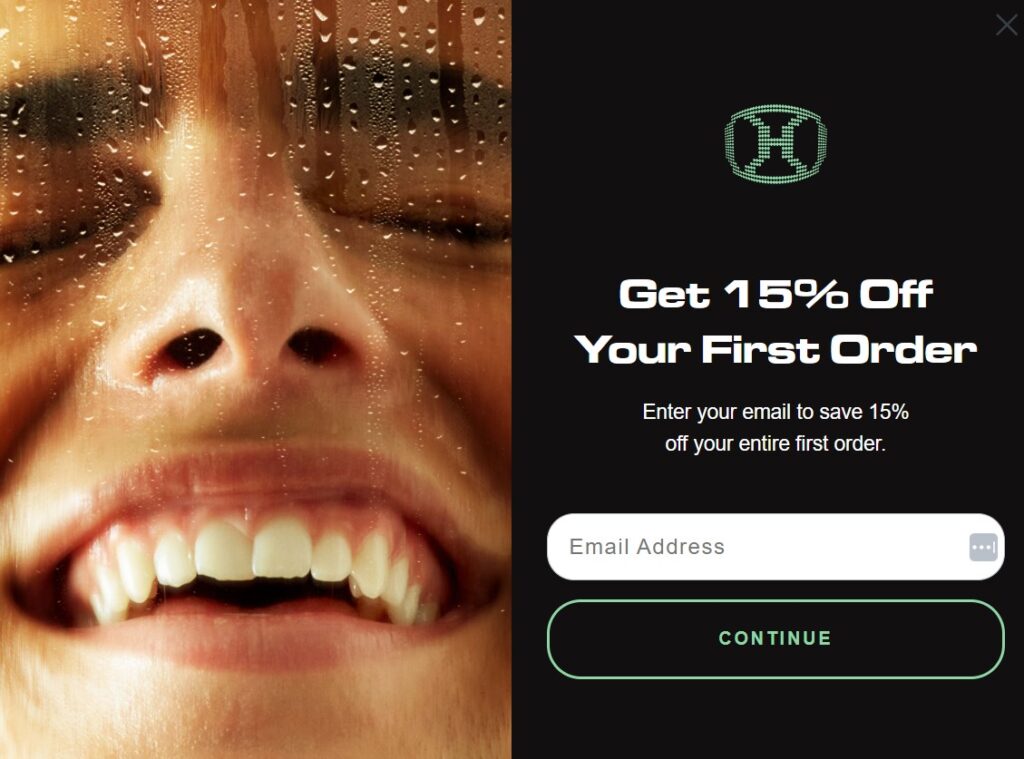
Image via Hawthorne
Simple, yet brilliant, right?
It’s also a perfect example of a multi-step form, which brands use to break down the process into smaller steps.
2. Simplify Your Opt-In Forms
Long or complex opt-in forms deter people from signing up and can hinder your email lead-generation efforts. That’s why it’s important to use simple opt-in forms that can be filled out quickly, without any hassle.
The easier it is to fill out your lead-capture forms, the more leads you’ll likely generate.
Here are some tips to simplify your email opt-in forms for increasing leads that you capture:
- Use only the necessary form fields and keep it as short as possible. This includes the name and email address of a prospect, or any other information that’s pertinent to achieving your marketing goals. Collecting only the essential data reduces the friction for the visitor. Tools like Clearbit Enrichment API helps in enriching your leads’ data only from their email address that you can use later for personalization.
- Keep the design minimal with a balance of text and visuals, and a clear focus on the call-to-action (CTA).
- If your form requires people to create an account, offer easy sign-up options, such as signing up using social media or Google logins.
Here’s an example of a simple form used by Hello Bar to get people to create a free account. It has just three form fields and also allows sign-up via Google to make the process easier.
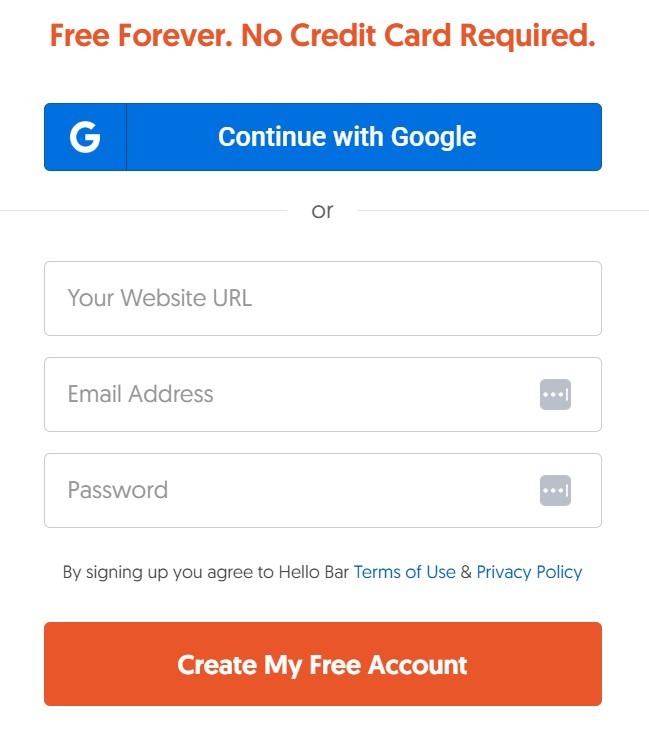
Image via Hello Bar
Blue Bottle Coffee takes simplicity to a whole new level by using a single form field to get people to subscribe to its newsletter.
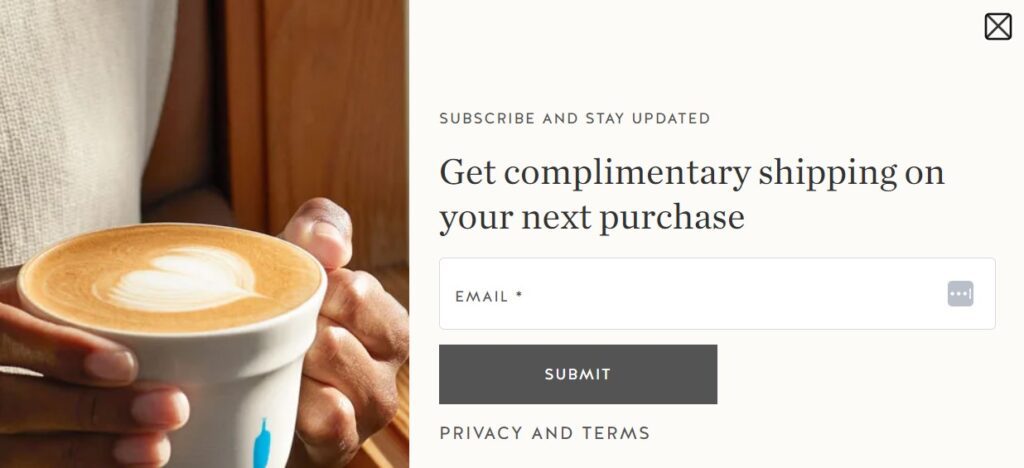
Image via Blue Bottle Coffee
3. Create Separate Landing Pages for Different Campaigns
One of the most common methods of email lead generation is using lead magnets to drive traffic to your website and using forms to convert visitors into customers.
However, directing traffic to your homepage will not be as effective as directing them to a landing page that’s optimized for conversions. The best practice is to create a unique landing page for each lead magnet.
Whether you’re running a giveaway, hosting a contest, asking people to take a quiz, or something else, create an optimized landing page for each.
Here are some tips for creating high-converting landing pages for email lead generation:
- Keep the design simple with minimal text and a clear focus on the call to action.
- Write a clear, concise, and compelling headline that introduces your offer.
- Use persuasive copy to convince people to click on the CTA and fill out the form on a landing page.
- Use strong action words in your calls to action to drive people to take action.
- Use contrasting colors, large font sizes, and other ways to make your CTA stand out on a page.
- Leverage visuals to highlight your offer. For example, if you’re giving an ebook in exchange for email leads, add its cover page image.
- Provide social proof by adding customer reviews, ratings, and testimonials.
- Conduct A/B tests on various elements to find out what works best for your target audience.
Influencer Marketing Hub, for example, has dedicated landing pages for each course, ebook, or resource that it offers on its website.
Let’s consider its landing page for a TikTok course, which covers everything from course modules to instructor qualifications to convey the value it provides to users.
What we found most interesting is that instead of saying it’s a free course, they used the term “100% discount” to improve the course’s perceived value.
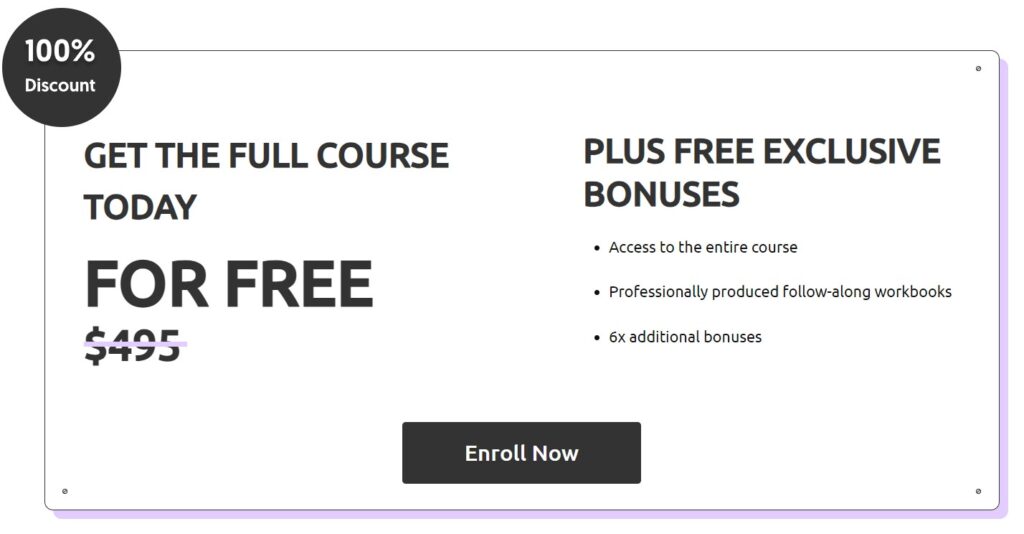
Image via Influencer Marketing Hub
By creating such landing pages for each lead magnet, it creates dedicated lead-generation funnels that generate email leads on autopilot.
4. A/B Test Your Forms and Landing Pages
Next on our list of email lead generation best practices is A/B testing.
A/B testing involves using two variations of a form or landing page, with just one variation. You can test two different CTAs, headlines, offers, or any other key element to see which performs better.
You show one version to half your site visitors and the other to the rest. The version that captures more email leads wins and you retain the variable used in that and test other elements in future experiments.
If you use a good popup builder like Hello Bar, you’ll get a built-in A/B testing feature. With Hello Bar, you can easily create different versions of forms and test them.
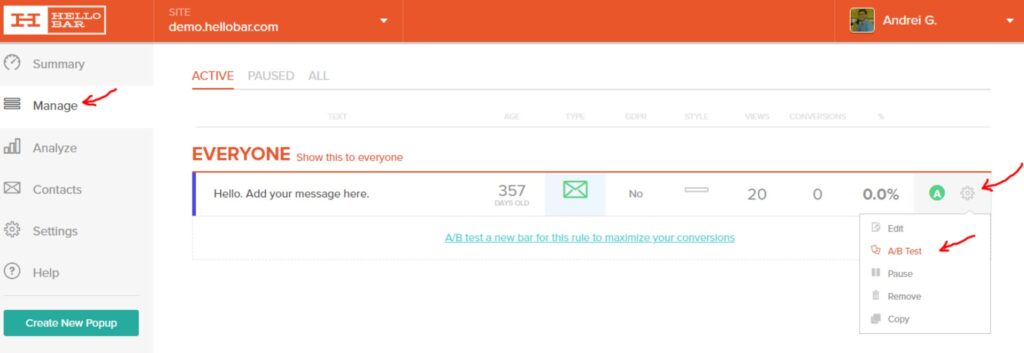
Image via Hello Bar
5. Remove Hesitation By Being Transparent
One reason why people hesitate to divulge their email addresses is the fear of being spammed with frequent, irrelevant emails.
You can get more signups by removing this hesitation. How can you do that?
Clearly mention what they can expect from your emails and how frequently you’ll send those emails. Mentioning the frequency of newsletters lets people decide whether they’re ok with receiving your emails. It also removes doubt regarding email spam.
You should also mention that they can unsubscribe at any time, no questions asked. This further eases the decision to divulge their contact details, helping you generate more email leads.
If you’re offering a free trial or asking people to create a free account, then mentioning that no credit card details are required would do the trick.
6. Create a Sense of Urgency or Scarcity
The best opt-in forms create a sense of urgency or scarcity to motivate people to take quick action.
While standard lead capture forms work well, offering an incentive for a limited time or creating a sense of scarcity is more effective.
So how can you create a sense of urgency or scarcity?
Here are a few ways:
- Present people with limited-time offers that will expire soon. It could be anything from a flash discount that’s valid for 15 minutes or an offer that lasts a few days.
- Use a countdown timer to further emphasize the need to take action quickly.
- Limit the number of registrations for your online events or webinars and mention how many seats are available to create scarcity and exclusivity.
- Offer early-bird incentives to people for registering for an event early.
- Use words like “limited-time”, “last chance”, and more to create a sense of urgency.
Check out this example of a webinar registration landing page, which uses a countdown timer to create a sense of urgency. The CTA “Reserve your seat” also gives the impression that seats may not be available later, creating a sense of scarcity.

Image via Workhuman
8 Strategies to Generate Email Leads
Here are some expert tactics you should consider for email lead generation. Use a mix of these and see which ones work best for your business.
1. Add an Opt-In form to Your Website
One of the most common email lead generation strategies is adding signup forms to a website to turn site visitors into leads.
You can place these on your website’s header or footer, sidebars, or anywhere on the page, without disrupting the main content. You may even use several CTA buttons on a page to nudge site visitors to sign up.
Check out this example from Hello Bar’s homepage, where a small CTA is placed at the top of the page. The top banner also has a form and there’s a “Get Started” button in the main navigation menu as well.
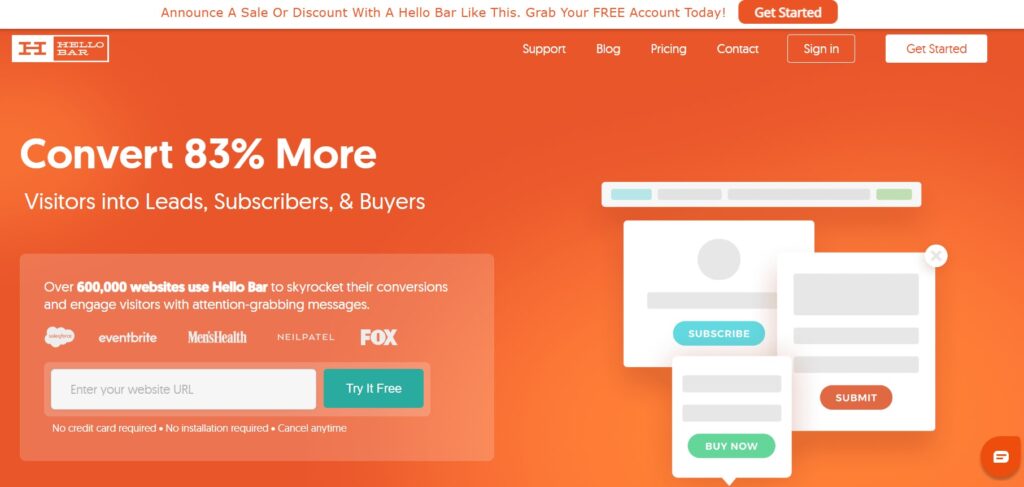
Image via Hello Bar
The top CTA banner is visible across web pages, providing a constant reminder to site visitors to take the desired action.
2. Use Popups for Surprise Deals and Offers
While some email opt-in forms stay on a page permanently, popups appear after a while and surprise site visitors with an offer.
These generally appear at the center of the screen and cover the main content. Though it may seem an intrusive email lead generation method, with the right timing and offer you can make it useful for your site visitors.
Popups can be triggered based on the time a visitor spends on the site, specific user actions like scrolling through a certain portion of a page, or other triggers. You need to experiment with various options and identify the best trigger option for your popups.
Since popups disrupt a site visitor’s browsing experience, it’s important that you provide enough value to spark their interest, instead of leaving them annoyed.
The best email lead generation popups offer a deal or incentive to capture and convert leads. Some examples include:
- A flat discount on the next purchase for people who sign up for your newsletter.
- A limited-time offer for people to subscribe to your newsletter, join your membership program, or buy something from your site.
- Access to free content or tools in exchange for providing email information.
Think about what your target audience values most and create a lucrative offer that they are likely to be tempted by. Use it in your popups to convert casual site visitors into genuine business leads.
Here is an example of a surprise popup offer that gives people a lucrative discount on the company’s all-access membership program. The words “spring sale” give the impression that it’s a limited-time offer, creating a sense of urgency.
Moreover, the popup concisely lists the various benefits of joining the program, giving people enough reason to avail of the offer immediately.
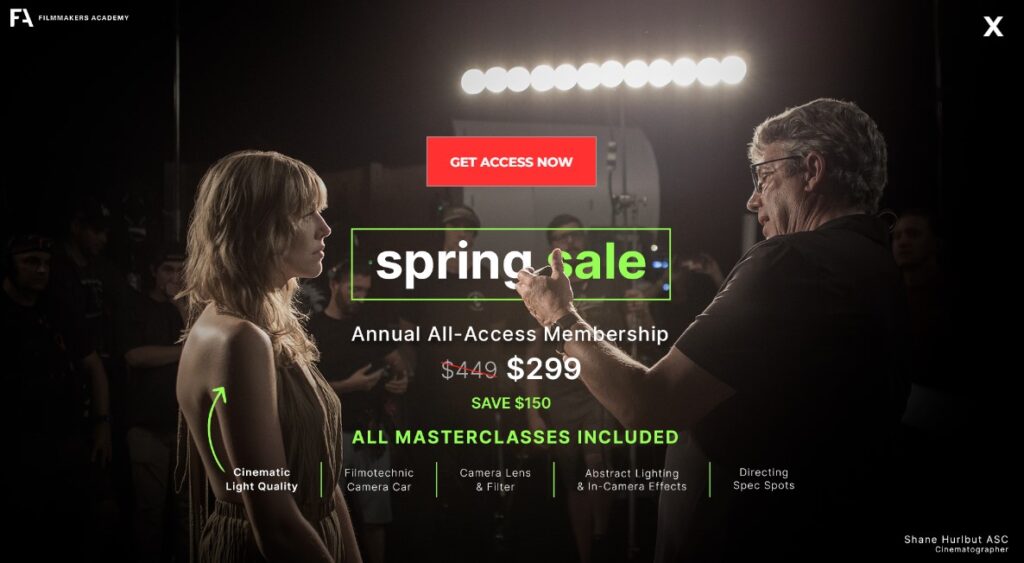
Image via Filmmakers Academy
One of the most effective popups you should include in your strategy is exit-intent popups. These appear right before a site visitor is about to leave your website and capture leads through an offer.
Hello Bar makes it easy to create these popups and the best part is that you don’t need any coding skills to implement them. You’ll get customizable templates you can use to quickly create and launch exit-intent popups for email lead generation.
Here’s an example.
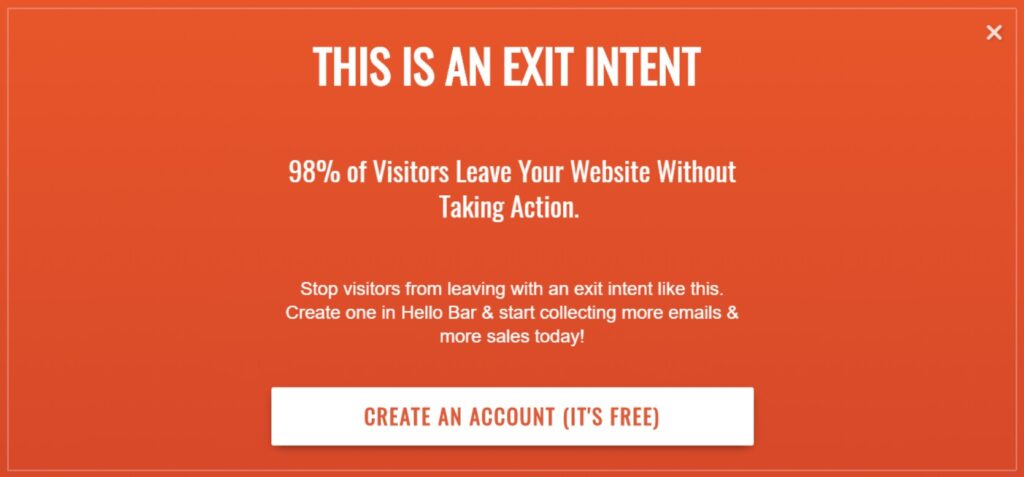
Image via Hello Bar
Pro Tip: To get more organic traffic to your website, also use SEO for lead generation.
3. Offer Gated Content in Exchange for Email Contacts
This is the oldest trick in the book, one that still works. Offering gated content is one of the tried and tested B2B lead-generation strategies that you must use.
How does it work?
First, you create a valuable piece of content that your target audience will find useful and relevant. This could be an ebook, whitepaper, research study, case study, evergreen content, checklist, or anything else.
Then, you hide that content behind a form, so that people can access it only if they fill out the form and give their email address. If your content seems valuable enough, people will gladly fill out the form and access it.
But how can you convince them of the value of your content?
You can do this by using compelling and persuasive copy on your form, which concisely lists the benefits they’ll derive from your content.
Here’s an example of gated content by Productboard. People can access a detailed research report by providing their work email addresses.
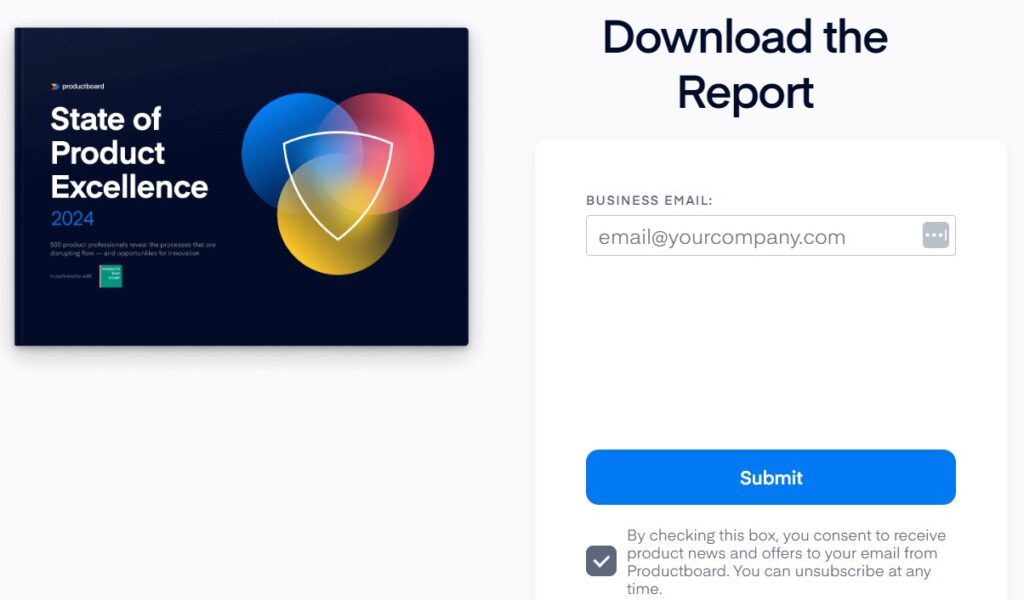
Image via Productboard
By keeping the form field limited to just one, the company makes it easier for people to get the content they desire, while the company gets new email leads. It’s a win-win.
4. Leverage Contests and Giveaways
If you’re looking for email lead-generation tactics that deliver quick results, then consider hosting contests and giveaways. You can host these on your website or social media and cross-promote to get the maximum participation.
If you’re hosting a social media contest, design a dedicated landing page where you can direct social media traffic. Ask participants to enter their email addresses to participate and get the results.
If you’re hosting one on your website, use a simple opt-in form or popup to announce the event and ask for people to enter their email addresses to participate.
Here’s an example of a website giveaway hosted by the cosmetics brand Maybelline. It uses five form fields to get some additional information on participants, other than their email addresses. Still, the form is short enough and easy for interested people to fill out.
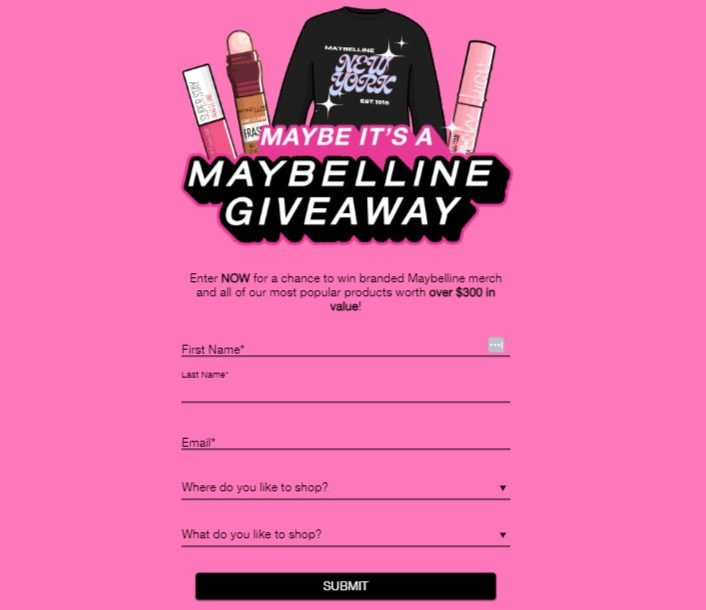
Image via Maybelline
5. Ask Your Site Visitors to Take a Quiz
One great way to get more email leads from your website is by using a quiz to ask for each consumer’s preferences and asking for their email address to provide personalized recommendations.
The strategy is simple:
- Add a quiz to your homepage and ask all site visitors to take the quiz to find the best products for their needs.
- When they complete the quiz, ask for their email address to get the results and personalized recommendations.
- Send those recommendations via email, preferably with an offer, to encourage purchases.
Take the eyewear brand Warby Parker as an example. It uses a quiz right on the top banner section of its website to engage site visitors.

Image via Warby Parker
When they complete the quiz, they can enter their email address to get the personalized recommendations sent via email or skip it and get the recommendations right there.
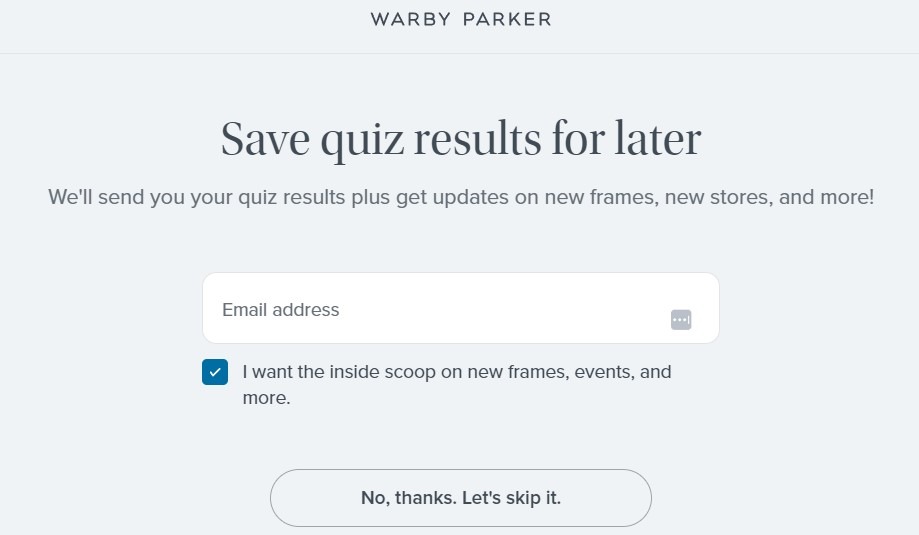
Image via Warby Parker
By giving this choice, it ensures that only interested consumers sign up for its emails, helping generate relevant leads.
6. Provide a Free Tool to Your Site Visitors
Another tried and tested strategy for email lead generation is offering free tools, such as calculators or generators, to your target audience.
These are great lead magnets that attract relevant traffic to your website. You can ask them to create a free account or provide their email address to use the tool for free or get the results.
The tool can be anything from a headline generator to a cost calculator. Just make sure it’s relevant to your industry and helps you reach targeted audiences.
Here’s an example of a free email subject line tester tool by CoSchedule. It first asks people to enter a subject line they want to test. Once they do, it asks them to create a free account to get the results.
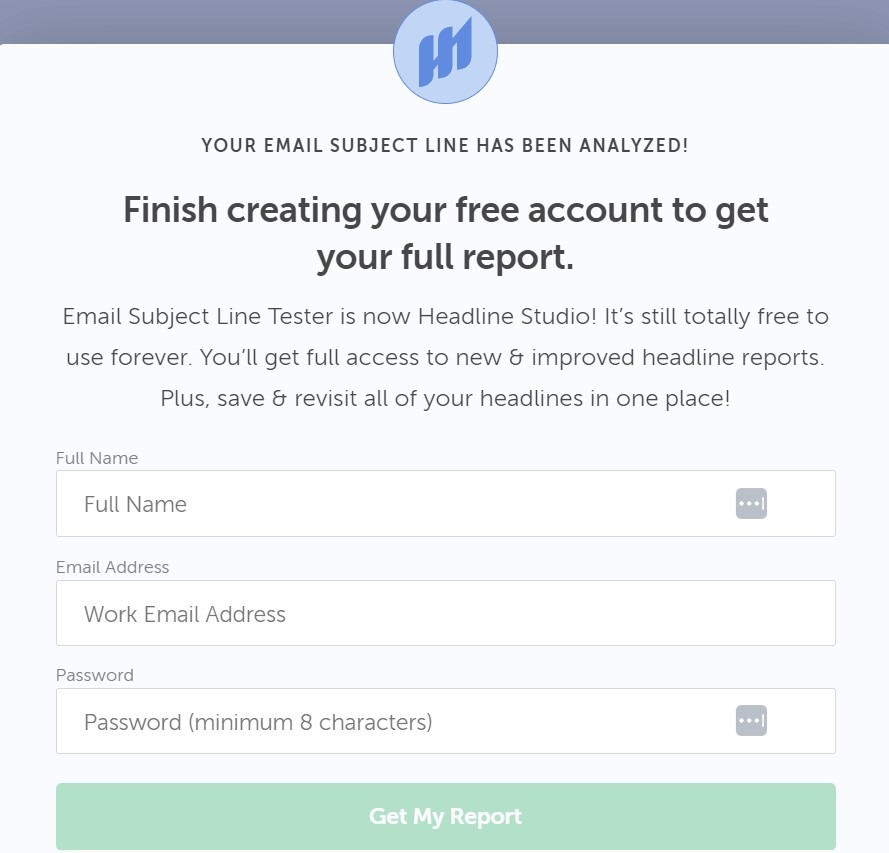
Image via CoSchedule
Anyone who’s interested in using this useful tool to create catchy subject lines must provide their email address. This creates an effective email lead-generation funnel for the brand.
7. Host a Webinar or Offer an Online Course
Hosting webinars or offering online courses are great for both B2C and B2B email lead generation. Anyone who wants to enroll must do so by providing their email contact information.
You can make the participation free or charge some amount for it, depending on the value your webinars or online courses offer.
Also, choose webinar or course topics relevant to your niche to attract relevant traffic and generate targeted email leads.
As always, create a dedicated landing page and enrollment form for each course, webinar, or online event that you host.
8. Explore Innovative Sign-Up Options
With the emergence of new technologies, there are more email sign-up options you can explore, rather than relying solely on website forms.
You can, for example, use AI chatbots to get newsletter signups by integrating a form within the bot’s interface. The chatbot will present the option to relevant users, based on its interactions.
Additionally, you may also consider offline signups using QR codes. This is especially helpful when you attend industry events and conferences and need an easy way to generate email leads, without the need to do it manually.
Anyone interested in your brand can simply scan a QR code to sign up for your newsletter or create a free account.
FAQ
Q1. Why do you need email lead generation?
Through email lead generation you can collect email addresses of prospective customers who might be interested in your brand. This allows you to reach out to and engage with these leads and encourage them to buy from you.
Email lead generation is the first step in running a successful email campaign, which is a cost-effective lead nurturing strategy.
Q2. How do you gather email leads?
There are numerous ways to collect email leads. Some top ones include:
- Website forms and popups
- Gated content or other lead magnets
- Contests and giveaways
- Quizzes or other interactive tools
- Webinars or online courses
Q3. How can Hello Bar help with email lead generation?
Hello Bar is an easy-to-use popup builder that helps you create different types of forms and popups to capture email leads. You can use its customizable templates to create popups in no time, without needing any technical skills.
Since lead-capture forms are crucial for email lead generation, Hello Bar is the perfect tool you need in your arsenal.
Q4. What is an email lead?
Anyone who’s shown interest in your brand and has opted to receive your emails is an email lead.
Q5. Which is the best free email lead-generation strategy?
The most widely used and free email lead-generation strategy is using lead capture forms and popups on your website. These help convince your site visitors to sign up for your emails. Once implemented, this email lead generation strategy works practically on autopilot.
Ready to Take Email Lead Generation to the Next Level?
This in-depth guide covers the best practices and top strategies for email lead generation. Use these to form a winning email lead-generation strategy and get more leads and, eventually, customers for your business.
We recommend experimenting with a few or all of these to figure out what works for you. Once you’ve identified the winning strategies, focus your email lead-generation efforts there. Good luck!







